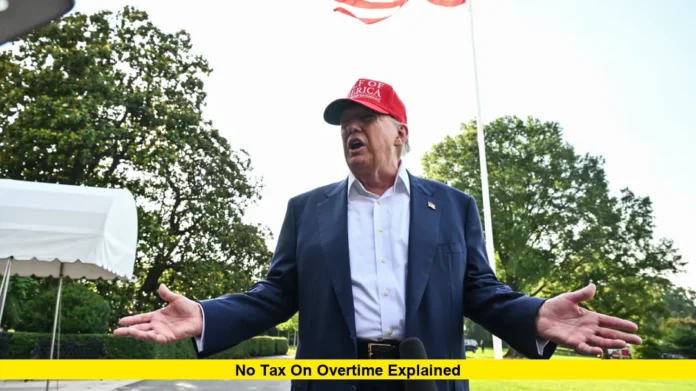The phrase “no tax on overtime” is grabbing national headlines again, and for good reason. In the wake of former President Donald Trump’s renewed campaign promise—backed now by actual legislation—millions of American workers are asking one thing: Is my extra pay finally safe from taxes?
On July 4, 2025, a new federal tax policy was enacted as part of what Trump dubbed the “One Big Beautiful Bill.” While the attention initially centered on his popular slogan “no tax on tips,” the fine print of the bill also introduces a similar perk for overtime workers. However, as many are now discovering, the reality isn’t as simple as the soundbites.
What Does “No Tax on Overtime” Really Mean?
At its core, the no tax on overtime policy allows eligible workers to deduct a portion of their federally taxable overtime income. The deduction is capped at $12,500 for individuals or $25,000 for joint filers, with certain income thresholds in place.
It’s important to understand that this isn’t a total elimination of all taxes on overtime—it’s a capped federal income tax deduction that phases out once a worker’s income crosses $150,000 individually or $300,000 jointly.
Read Also-When Does No Tax on Overtime Start? Everything You Need to Know in 2025
Key Point Summary
| Category | Details |
|---|---|
| Deduction Type | Federal income tax deduction |
| Eligible Earnings | Overtime pay only |
| Annual Limit | $12,500 (individual), $25,000 (joint) |
| Income Phase-Out | Begins at $150,000 (individual) |
| Payroll Taxes Affected | No — Social Security & Medicare remain |
| Valid Through | 2025 to 2028 |
No Tax on Overtime Explained in Detail
The no tax on overtime clause has sparked hope for millions of hourly workers who often rely on overtime to make ends meet. But there are conditions attached.
Who Qualifies?
- Only employees whose overtime pay meets the Federal Labor Standards Act (FLSA) definition qualify.
- Overtime must be officially recorded by the employer.
- Independent contractors and gig workers are not currently included.
How Does It Work?
- Eligible workers will receive a new line item on their annual W-2 form showing their deductible overtime earnings.
- When filing taxes, this amount can be subtracted from gross income—reducing the amount subject to federal income tax.
What It Doesn’t Cover
- Payroll taxes still apply. You’ll continue paying into Social Security and Medicare on your full earnings.
- State and local taxes may still tax the overtime portion, depending on where you live.
- Non-FLSA overtime (such as voluntary overtime or state-specific classifications) may not qualify.
Also Read- No Tax on Overtime: Major Breakthrough for American Workers
Two Deductions, One Controversy
The no tax on tips and no tax on overtime policies are clearly aimed at America’s working class. But critics argue that the complex eligibility rules and income caps will leave out many of the very people the measures were supposed to help.
For example:
- Cash tips are deductible—but Venmo or card tips may not qualify.
- High-income earners benefit more from the deductions in terms of dollar value.
- Workers in states that don’t conform to federal tax laws may not see much difference at all.
Some are calling this a political gimmick disguised as a financial benefit.
What Should Workers Expect Now?
Here’s what employees should prepare for:
- Track all overtime hours carefully. Keep personal records, especially if your employer doesn’t itemize them in real time.
- Check income thresholds. If your gross annual earnings approach $150,000 (or $300,000 for couples), your eligibility will begin to phase out.
- Talk to a tax professional. With new deductions and paperwork changes coming into play, a preparer can help ensure you take full advantage of the policy.
What Employers Need to Know
Businesses will also bear responsibility under the new plan. Key steps include:
- Adjusting payroll systems to separately report qualifying overtime on employee pay stubs and tax forms.
- Educating HR teams on the implications of misclassifying employee earnings.
- Avoiding manipulation of schedules to shift regular hours into “overtime” for tax gain—something tax enforcement agencies are already watching closely.
Public Reaction Is Mixed
Reactions on social media, especially among service and healthcare workers, have been a mix of optimism and skepticism. While many welcome any relief, others are wary of policies that appear generous but contain loopholes.
Quotes from online forums show the divide:
- “Finally, some real tax help for people like me working double shifts.”
- “Typical bait-and-switch. The rules are so specific that hardly anyone will qualify fully.”
Still, as of now, the policy is federal law, and the IRS has 90 days to issue formal guidance.
What’s Next?
- IRS will publish clarification on what constitutes “qualified overtime.”
- Employers must begin compliance updates immediately.
- Workers will start seeing the changes reflected in their 2025 W-2s.
- Full implementation is expected by the 2026 tax season.
Conclusion
The no tax on overtime provision is more than a campaign soundbite—it’s part of a complex legislative rollout that could offer meaningful tax relief to millions of American workers. But as with many political promises, the benefit lies in the details. While it may not be a total tax exemption, it’s a step toward rewarding hard work in an economy where every extra hour counts.
Stay tuned for the latest developments and exclusive updates on no tax on overtime and tip-based earnings. Share your thoughts in the comments—will this new tax deduction really benefit working Americans?
